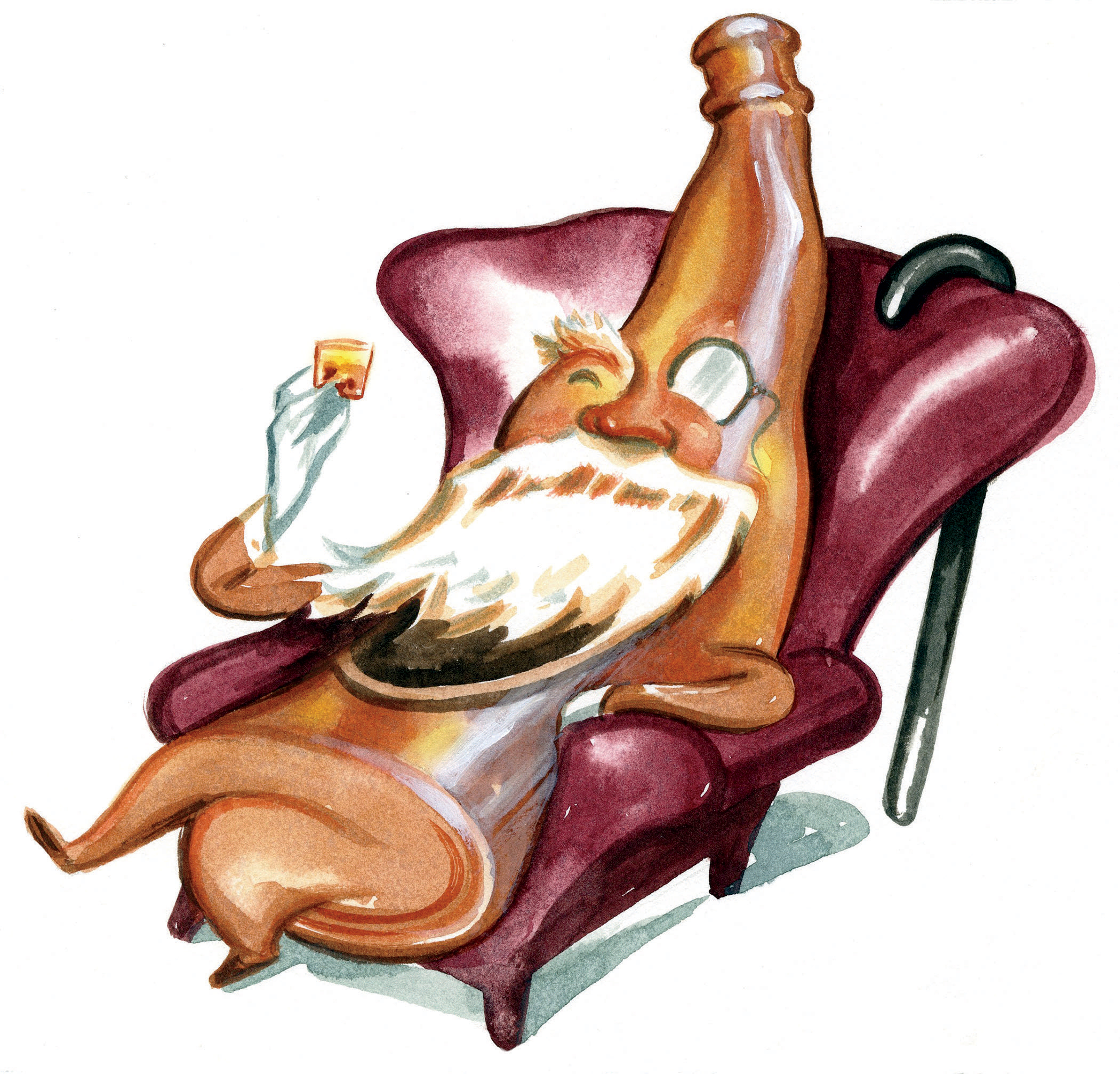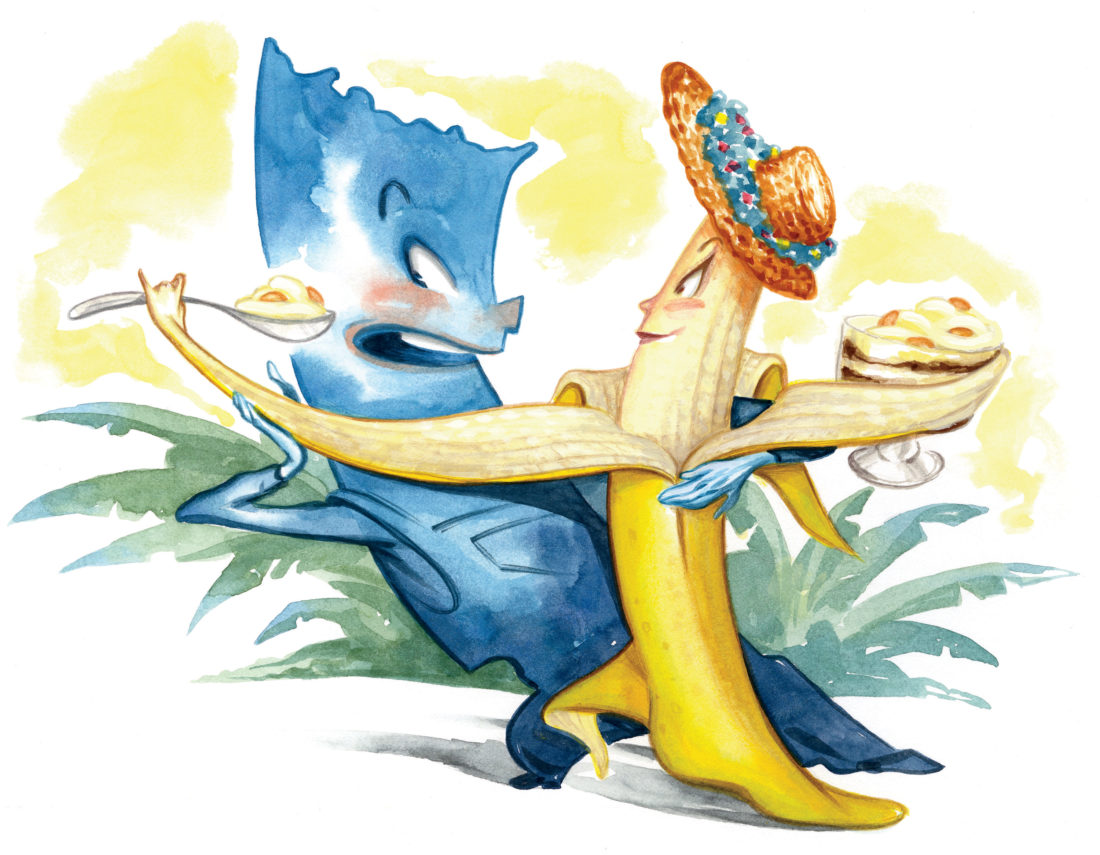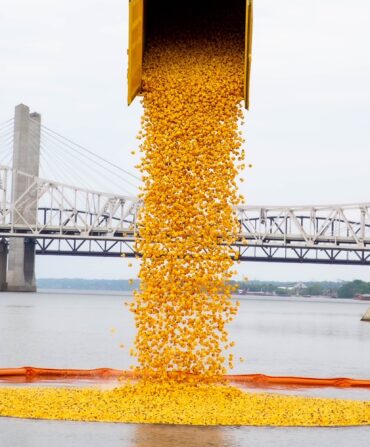Going Bananas
Centerville, Tennessee, October 7–8
Whether it’s the Collard Festival in Ayden, North Carolina, the World Grits Festival in St. George, South Carolina, or the Boudin Cook-Off in Lafayette, Louisiana, the South has no shortage of rib-sticking events dedicated to our favorite foods. So when a group of citizens from tiny Centerville, located an hour southwest of Nashville, wanted to start a new festival to support area nonprofits, it did its homework, searching for some overlooked dish or crop in need of a little love. “We thought about a festival for beans or cornbread, and much to the chagrin of a few folks, we even thought about starting a broccoli festival,” says the planning committee’s chairman, John Blackburn. “Eventually, we found out that although there were a couple of banana festivals, there were no banana pudding festivals.” Bingo. The National Banana Pudding Festival (October 7–8) was born. Now in its eighth year, the fete pulls in hungry visitors from as far away as Japan looking to get their fix. “Who would have thought you could run out of two tons of banana pudding like we did last year?” Blackburn says. “This year, we’re making four.” Get your tasting spoons ready for the amateur cook-off. Then peruse the Puddin’ Path, a walkway lined with samples that ends at the Puddin’ to Go Tent, where you can purchase your favorite “nanner” treat before you (ahem) split. bananapuddingfest.org
SHOPPING
Alabama
Lost in Transportation
Anyone who flies frequently knows the quiet desperation of watching an airport baggage carousel go around and around,
only to discover your suitcase never made its final destination. After a day or so in the same wilted clothes, you’re usually reunited with your stuff. But what happens to the bags that never circle back? Turns out, if they’re not claimed after ninety days, airlines sell them to the Unclaimed Baggage Center in Scottsboro—the only place in the country that cleans and then resells at a discount lost luggage and everything packed inside. The expansive warehouse spans more than a city block, and each fall hosts the Ski Sale (November 4), a blowout focused on winter sports—not exactly something Alabama is known for. “We get
a good snow around here about once a decade,” says Brenda Cantrell, a center staff member. “But people from West Virginia, Wyoming, and enthusiasts from all over the country make the trip here for this sale each year.” First-time visitors are often shocked by the top-of-the-line items available—Rossignol alpine skis, boots by Austrian retailer Strolz, and puffy Patagonia down jackets. Finders keepers, folks. unclaimedbaggage.com
MUSIC
Arkansas
Tuning In
Back in 1986, Helena native Bubba Sullivan and a handful of friends “had an idea,” he says, “to put a bunch of people out in a field, cook about a thousand pounds of barbecue,
and play some blues.” Thirty-one years later, the King Biscuit Blues Festival (October 4–7) still attracts hordes of eager blues enthusiasts every fall. No longer in a field, the event occupies the five blocks of historic Cherry Street in downtown Helena, with multiple stages, street performers, food trucks, people camping (you’ll find Tent City a half mile from the festival; with a seventy-dollar camping fee, it’s first come, first served), and a wingding by the river. The name pays homage to Helena’s King Biscuit Time, a legendary daily radio show (launched in 1941) that broadcasts live performances by Delta blues artists such as Sonny Boy Williamson, pausing every
so often for ads from the show’s sponsor, the King Biscuit Flour company. The young Muddy Waters and B. B. King were regular listeners. This year’s headliners include
JJ Grey and Mofro, Tab Benoit, and Warren Haynes’s blues-rock outfit Gov’t Mule. Postfestival, keep the music playing with a stop at Sullivan’s store on Cherry, Bubba’s Blues Corner, a long-standing mecca for rare and limited-edition blues albums. kingbiscuitfestival.com
GARDEN
Florida
Farm to Tablescape
A sliver of land outside Florida’s Ocala National Forest is known as the Fern Capital of the World. Not without reason. The farms around the towns of Pierson and Seville grow the majority of the floral industry’s leafy supporting actors—the maidenhair, feather, foxtail, and umbrella ferns, among others, that help carefully arranged blooms pop. On November 18, the Certified American Grown Field to Vase Dinner Tour, a circuit of alfresco suppers set on the country’s most dazzling greenery and flower farms, will celebrate the region’s legacy with a meal at FernTrust, a 350-acre foliage farm in Seville. Enjoy a cocktail and a tour of the property, followed by a wine-paired dinner at communal tables. “At each of our dinners, we want the arrangements on the table to
be as fresh, local, and sustainable as the food on the plates,” says tour administrator Kasey Cronquist. Non-Floridians seeking a botanical bash closer to home can check the series’ full schedule. In October, Hope Flower Farm in Waterford, Virginia, for example, will host an early fall supper just in time to see the garden roses bloom. americangrownflowers.org
OPENING
Georgia
Coming Attraction
Much of the design at Atlanta’s iconic Fox Theatre—the “Fabulous Fox,” circa 1929—while splendid, ornate, and eye-catching, is a mirage. The “gold leaf” is not real gold; the seemingly wooden beams are plaster; the fireplaces lack chimneys; many Moorish architectural details are trompe l’oeil. But the theater’s much-heralded new expansion—slated for a fall unveiling—is no smoke-and-mirrors act. The iconic playhouse is gaining a total of ten thousand square feet, mostly in the form of an exclusive lounge called the Marquee Club. With five bars spread across three levels, the Marquee will open before shows and during intermission. Annual memberships, which begin at $2,500, include priority presale ticketing, concierge and elevator services, and reserved parking, plus the chance to mingle with Atlanta’s beau monde. But the real showstopper might be the theater’s rooftop terrace, open to members for the first time in
more than fifty years. foxtheatre.org
DRINK
Kentucky
Aged to Perfection
Getting your hands on Kentucky’s rarest bourbons takes serious time, money, and a solid network of insiders—or a ticket to Taste of the Decades (October 26) at the Tousey House Tavern in Burlington. Brad Wainscott, the managing partner of the restaurant, which is set inside an 1822 Federal-style home, leveraged his industry connections to round up some of the best (and oldest) bottles in the state. “People
call them dusties,” Wainscott says, “because they sit in the back of a closet until someone digs them out.” Around platters of ham biscuits, deviled eggs, and fried chicken, you can sample vintage Four Roses, Buffalo Trace, and Van Winkle alongside a who’s who of the whiskey world—
folks like the 2014 Garden & Gun Made in the South Awards winner Dixon Dedman, who crafts Kentucky Owl Straight Bourbon Whiskey in Harrodsburg, and the legend himself, Julian Van Winkle III. For a price, a lucky (and generous—all proceeds benefit children’s cancer research) few can join
Van Winkle in a private tasting room, where he will speak about some of the scarcest bottles on the planet before unsealing several. There might even be a 1984 Van Winkle Family Reserve, capped in red wax. “It was made in 1968 or ’70 by my dad, and I bottled it in 1984,” Van Winkle says, adding, “That one’s priceless.” touseyhouse.com

Tim Bower
STYLE
Louisiana
Garden Gala
The beauty and diversity of the garden “rooms” at New Orleans’ Longue Vue House & Gardens—including one filled with an impressive collection of Louisiana irises—recently earned the site a spot on the American Public Gardens Association’s list of “10 gardens worth traveling for.” The property’s circa-1939 home is no slouch, either. “It is still furnished much as it was by its original owners, the [wealthy and civic-minded] Sterns, with their warmth and personality,” says interior designer and Friends of Longue Vue president Louis Aubert. “Mrs. Stern was really into lamp shades. Marveling at them alone is worth a visit.” But no one would have the opportunity to see any of it if not for the money raised at this National Historic Landmark’s annual Longue Vue House & Gardens Essence of Style Symposium (November 2–3). The event draws architects, interior designers, and horticulturists from New Orleans and beyond, but it’s not just for industry insiders. Anyone with an appreciation and passion for preservation is welcome. While Friday’s luncheon at the Cannery (near City Park) with Richard Keith Langham—an Alabama-bred New York designer whose clients have included John Goodman and Jacqueline Kennedy Onassis—is billed as the main event, Aubert stresses the appeal of Thursday night’s reception. “Held at the house, it offers the opportunity to see inside and to wrangle some one-on-one time with Langham,” he says. “He’s a Southern boy, and that shows in his work.” longuevue.com
GARDEN
Maryland
Great Estate
Instead of a Big Apple penthouse with Central Park views, the early-twentieth-century leather manufacturing heir Harvey S. Ladew opted for a quiet life in Monkton, Maryland. There, amid his 250 acres of lush countryside, he pursued his primary interests—foxhunting and shaping box-
wood topiaries into scenes from the field. Five years before his death in 1976, he opened twenty-two acres of the private retreat to the public as the Ladew Topiary Gardens. If he still walked the grounds today, no doubt you’d find him in the front row during the Ladew’s Fall Lecture Series. Speakers throughout October and November include Kent Russell, a.k.a. PBS’s Garden Guru, and the sculptor Mary Ann Mears, who will guide visitors through a retrospective of her oversize geometric installations scattered throughout the gardens. From inside the estate’s eighteenth-century chestnut post-and-beam barn, other experts will cover conservation,
native foliage, and shade gardening. Once you’ve got a patch of sun-averse hostas thriving, though, keeping the deer away
from them is still on you. ladewgardens.com
DESIGN
Mississippi
Neighborhood News
Read: In Celebration of the Front Porch
FOOD
North Carolina
Dream Houses
There’s no sugarcoating it: The annual National Gingerbread House Competition, held at the Omni Grove Park Inn in Asheville, is intense. The event pits an average
of 150 architecturally minded amateur bakers from across the country against one another, vying for bragging rights and a grand-prize package of five thousand dollars and a weekend at head judge and chef Nicholas Lodge’s sugar-arts school in Norcross, Georgia. Thanks to rigid rules mandating that every structure be at least 75 percent gingerbread and 100 percent edible, and conform to precise measurements—plus crowds of up to sixty thousand over the nearly six weeks the structures are on display (this year November 26–January 4)—
composures can crumble under the pressure. “One year, a man smashed his entry to bits because he didn’t make it into the
top ten,” says Tracey Johnston-Crum, the resort’s director of community outreach. It’s not just the entrants who sometimes crack. “We had a group of adult attendees climb over the ropes guarding the houses and bite them,” Johnston-Crum recalls. Maybe the nostalgia of it all nudges some folks back to childhood. Or perhaps the locally brewed gingerbread beer on tap in the lobby plays a part. Naturally, though, most guests at this historic hotel mind their manners. omnihotels.com

Tim Bower
OPENING
Oklahoma
One for the Books
The idea of a “third place,” a regular haunt outside one’s home and work space, is important to Jeff Martin, who together with Cindy Hulsey founded the Tulsa Literary Coalition. The group, which has hosted big-name authors (Stephen King, Salman Rushdie, David Sedaris, Elizabeth Gilbert) in locations around the city for years, hopes to manifest that concept with Magic City Books. “It’s the first new independent bookstore in Tulsa in decades,” Martin says. Set to open in November, Magic City (a nod to the nickname coined during Tulsa’s early-twentieth-century oil boom) will occupy thirty-seven hundred square feet in a 1925 brick warehouse in the heart of the Brady Arts District, one of the city’s oldest neighborhoods. Stocking around twenty thousand curated titles (“an element you don’t get with an algorithm on a computer,” Martin jabs), the store will also serve coffee, beer, and wine. The venture is funded largely by the George Kaiser Family Foundation, a local restoration-minded nonprofit. The coalition also crowdsourced more than half a million dollars. “We’ve had a huge response from the community,” Martin says. “It’s not even really about the books: It’s about the culture around the bookstore.” magiccitybooks.com
LITERATURE
South Carolina
A Real Page-Turner
The Charleston Festival in Sussex, England—held at the former home of painters Vanessa Bell and Duncan Grant, who were part of the Bloomsbury Group, a cohort of writers and intellectuals such as Virginia Woolf, E. M. Forster, and T. S. Eliot—is one of the largest and most successful bookworm gatherings in the U.K. This year, the Charleston (South Carolina) Library Society—which has fostered Lowcountry literary minds for longer than America has been a country—is partnering with the like-minded British group to bring lit lovers to the Holy City for the inaugural Charleston to Charleston Literary Festival (November 3–5). “We see this as something that will be a yearly, growing collaboration,” says Anne Cleveland, the society’s executive director. “Like the literary Spoleto.” Southern historian Marjorie Spruill, Nigerian poet Ben Okri, and British novelist Bernard Cornwell, among others, will discuss subjects ranging from feminism to race to the Charleston Renaissance, which took place between the two world wars. Also on the lineup: an advance screening of Breathe—a biopic about Robin Cavendish, a pioneering advocate for the disabled—introduced by the film’s Oscar-nominated screenwriter, William Nicholson. And dyed-in-the-twill Anglophiles can rub elbows with the U.K. ambassador, who will visit town for the event. charlestontocharleston.com
SPORTING
Texas
Art of the Game
Out of all ancient deities, Diana, goddess of the hunt, is the one you really ought not portray naked. According to Greek and Roman mythology, when a young hunter named Actaeon chanced upon her bathing, she turned him into a stag and set her hunting dogs on him. Yet, when the nineteenth-century American sculptor Augustus Saint-Gaudens was commissioned to create a weather vane for Madison Square Garden, he chose to depict Diana unclothed and then had her bathed in electric light high in the Manhattan sky. The piece caused such a sensation that Saint-Gaudens decided to make several hundred or so desk-sized bronze reproductions. One of these mini Dianas will be on exhibit at the Amon Carter Museum of American Art in Fort Worth for Wild Spaces, Open Seasons: Hunting and Fishing in American Art (October 7–January 7), a collection of sporting art from the early nineteenth century to World War II. The touring exhibition is a joint effort among four U.S. museums; Fort Worth will be its final stop. For Carter curator Maggie Adler, Diana is a personal favorite (Adler was a competitive archer); another is Eel Spearing at Setauket, an 1845 William Sidney Mount oil painting, owned by the Fenimore Art Museum in New York, which “almost never travels,” she says. One other notable piece is the oil painting A Tight Fix (1856), which depicts a knife-wielding hunter facing down a fierce black bear. Unlike Actaeon, at least he appears to have a fighting chance. cartermuseum.org
FOOD
Virginia
All Fired Up
In 1824, John Dabney was born into slavery in Hanover County, Virginia. As he grew up, Dabney gained regional acclaim for his cooking and bartending skills. He allegedly served one of his famed mint juleps to the Prince of Wales when the royal visited the Commonwealth in 1860, and he opened his own catering business and restaurant after the Civil War. Richmond’s Fire, Flour & Fork festival (November 2–5) will pay tribute to his legacy as well as the contemporary culinary lights leading the way in the city’s continuing gastronomic evolution. On November 2, the Dabney Dinner will honor the pioneering cook with a premiere of a new documentary about his life, followed by plates from chef Michael Hall of Spoonbread Bistro as well as Velma Johnson of Mama J’s. A global barbecue blowout with styles from Korea, Jamaica, and Vietnam is scheduled for Friday, November 3. On Saturday, hit the Latin-inspired carnival on the grounds of the Valentine history museum. Or jump on a behind-the-scenes tour of C. F. Sauer, the local spice company, headquartered downtown, that sources ingredients from all over the world. “Richmond has been a global marketplace for hundreds of years,” festival cofounder Maureen Egan says. “We want to show that those connections are still happening today.” fireflourandfork.com
ART
Washington, D.C.
Home of the Brave
“This kind of work is what I got into art for,” says Asma Naeem, a curator of the National Portrait Gallery’s powerful exhibit The Face of Battle: Americans at War, 9/11 to Now, a compelling study of modern warfare and its personal toll. The exhibition, on display through January 28, showcases the works of six artists in media ranging from painting to photography. More than fifty portraits depict active-duty men and women as well as veterans, putting a very human face on ongoing conflicts. “The exhibit will help you better understand their sacrifice by showing who they are as individuals,” Naeem says. It’s not just the subjects who’ve been affected, either. Several of the featured photographers stood shoulder to shoulder with the soldiers they documented, and one, Tim Hetherington, was killed while covering the 2011 insurgency in Libya. npg.si.edu
HISTORY
West Virginia
Walk the Line
Read: The Mason-Dixon Line turns 250 years old








